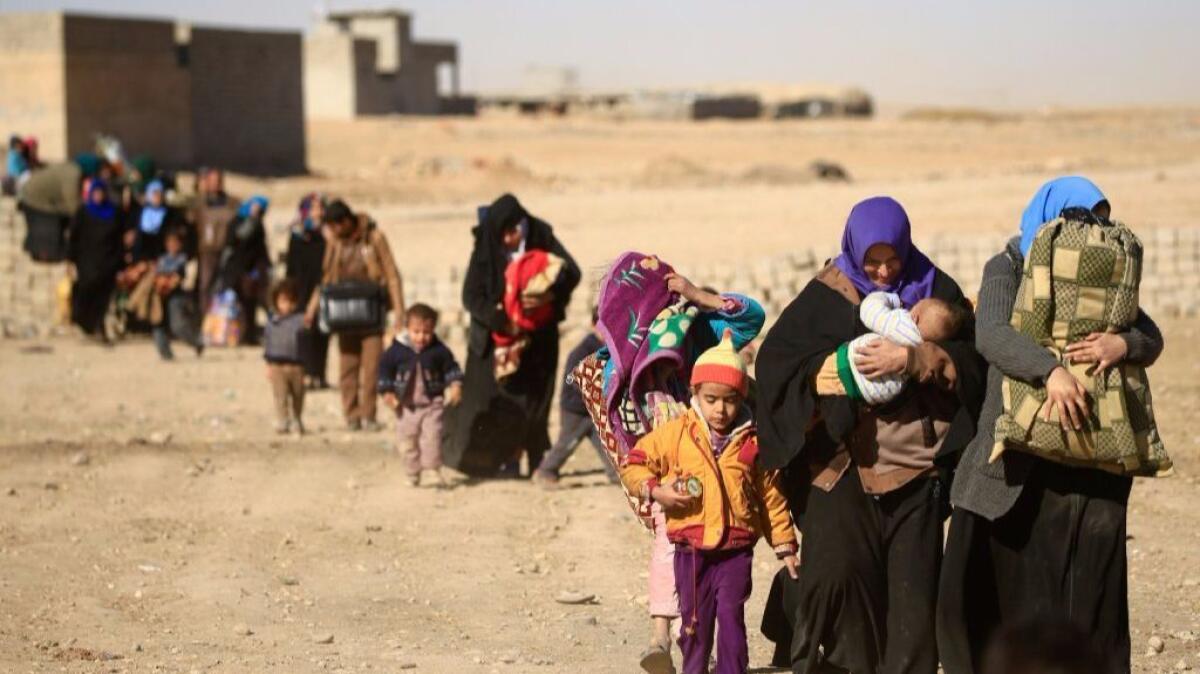Review: ‘Frontline: Iraq Uncovered’ captures the extreme fallout of a country divided

- Share via
The black flags of the Islamic State are coming down in Mosul, prisoners are being released, citizens freed.
That’s what the television media has been reporting lately in the few spare minutes a week that aren’t populated by Trump tweets and scandal.
But when the documentary “Frontline: Iraq Uncovered” goes where most American media do not anymore, i.e. outside the studio and into the battlefields of Iraq, it finds a different story.
The hourlong documentary, which airs Tuesday on PBS, visits the ravaged towns and provinces recently recaptured from the Islamic State by Iraqi forces only to find citizens terrorized by another faction — their liberators.
It’s a troubling development that threatens to further destabilize Iraq, spill over into other regions of the Middle East and possibly incite more terror incidents around the globe.
British Iranian journalist Ramita Navai goes on the ground and shows how the involvement of Shiite Muslim militia in the fight against the Islamic State has incited a new round of sectarian violence.
Large, organized militias that fight alongside the Iraqi army have played a critical role in weakening the Islamic State’s grip in predominantly Sunni areas such as Ramadi and Fallujah. But some are exacting a politically motivated revenge on Sunni civilians they deem to be terror members or collaborators.
As the “Frontline” documentary explains, it’s a targeted persecution with historical roots.
Iraq is a Shiite Muslim majority country, and many Shiites claim they were oppressed for decades under the predominantly Sunni leadership of Saddam Hussein. After Shiites gained more representation in government following the 2003 U.S. invasion, many Sunnis have claimed they are now being oppressed.
Enter the Islamic State, which identifies as Sunni (albeit a warped version of Islam’s largest sect). It exploited age-old sectarian tensions to gain support in the Sunni areas they captured, subjecting anyone who it considered a non-follower — Shiite, Yazidi, Sunni who opposed them — to a barbarism rivaling that of the Crusades.
The presence of the Islamic State is evident everywhere Navai goes — roads decimated by IEDs, burning oil wells, battlefields littered with dead bodies.
She embeds with the Shiite militia group Badr as they fight the Islamic State and then process the displaced Iraqis who they’ve just liberated. The relief on the faces of families as they are broken out of Islamic State territory soon turns to dread when they face a new round of interrogators.
“There’s a 90% chance that an ISIS member is among the displaced families,” says a militia leader as they separate terrified men from the women and children and immediately take away a man who the rescued group says was an Islamic State sympathizer who blackmailed them. The cameras are not allowed to follow. (ISIS is an acronym for the Islamic State.)
As Navai points out, it’s difficult to tell the enemy from a simple farmer or merchant (they could be one and the same), but little proof is needed before husbands, sons and fathers are swept away by militia. If recent history is any indication, says Navai, they — like hundreds before them — will never be heard from again.
The Badr and other militia, like Hezbollah Brigade, are supposed to answer to the Iraqi government and turn suspected Islamic State collaborators over to the justice system to be tried. But in the documentary, a Shiite fighter points to horrific video on his phone of civilians being tortured by the Islamic State as the reason why his forces must act quickly.
Navai, who won an Emmy for the 2011 “Frontline” installment “Syria Undercover,” interviews former militia fighters, captives who escaped militia prisons, refugees who witnessed the murder of their families and the rare politician willing to admit it’s a systemic problem the government is either ignoring or benefiting from.
The film shows the destroyed Sunni mosques of Diyala province, and in other scenes, beautiful rural green fields where dead bodies dumped in the creek are a regular part of the landscape. In a refugee camp, a grieving mother shows photos of her three sons, all young men, all executed in her home when the militia moved into town to push out the Islamic State.
What’s harder to capture in this documentary is the reality that most everyone left in Iraq has been brutalized, by Sunni or Shiites or U.S. troops or random thugs hiding behind various empty causes. Vengeance is an endless cycle, and it’s exploited by political factions — in and outside Iraq — for strategic and economic gain.
Watching this path toward civil war unfold, perpetuated by sectarianism and a government crippled by its own corruption, is heartbreaking.
Navai drives past a bombed-out main street where aid workers are passing out food and water. A group of boys who, if born 10 years earlier, might be playing soccer is, instead, fighting over a bag of bread.
This documentary captures the extreme fallout of a country divided, run by incompetent leaders who fan the flames. There’s a lesson here, even if most of the U.S. media has stopped paying attention.
ALSO:
Frontline documentary gets with NSA’s spy ‘Program’
‘Frontline’ examines right-left rift in ‘Divided States of America’
PBS explores ‘ISIS in Afghanistan’ in ‘Frontline’ documentary
The complete guide to home viewing
Get Screen Gab for everything about the TV shows and streaming movies everyone’s talking about.
You may occasionally receive promotional content from the Los Angeles Times.




